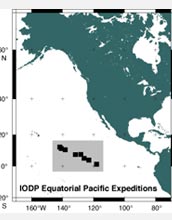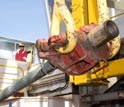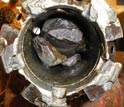|

Press Release 09-089
Sea-floor Sediments Illuminate 53 Million Years of Climate History

Drillship JOIDES Resolution completes first expedition as redesigned ship
May 1, 2009
The Integrated Ocean Drilling Program (IODP) drillship JOIDES Resolution is returning to port in Honolulu this week after a two-month voyage to chart detailed climate history in the equatorial Pacific Ocean. The expedition was the first of two back-to-back voyages of a scientific project called Pacific Equatorial Age Transect (PEAT). It was the first international scientific drilling expedition after the JOIDES Resolution underwent a multi-year transformation into a 21st-century floating science laboratory. The PEAT expeditions are recovering a series of continuous historical records in sediments at a number of different geographic locations beneath the equatorial Pacific Ocean. The first research effort, called Expedition 320, took place March 5 through May 4, 2009; Expedition 321 will take place from May 5 through July 5, 2009. Co-chief scientists of Expedition 320 were Heiko Palike of the University of Southampton, U.K., and Hiroshi Nishi of Hokkaido University in Japan. On Expedition 320, scientists obtained records from the present back in time to the warmest sustained "greenhouse" period on Earth, which took place around 53 million years ago. Shipboard studies have revealed that changes in ocean acidification linked to climate change have a large and global impact on marine organisms. "The sediments collected during this expedition offer an unprecedented window to the evolution of the tropical Pacific, one of the largest and most climatically important ocean regions on Earth," said Julie Morris, director of NSF's Division of Ocean Sciences. "In focusing on a time period that includes some of the best analogs for abrupt climate change, extreme climate events, ocean acidification, and 'greenhouse' worlds, the results will give us insights into the potential impacts of future climate change." Environmental changes are recorded by shells of tiny microfossils that make up the deep-sea sediments. "We can use the microfossils and layers of this sediment 'archive' as a yardstick for measuring geologic time," said Expedition 320 co-chief scientist Hiroshi Nishi. "This will allow us to determine the rates of environmental change, such as the rapid first expansion of large ice-sheets in the Antarctic 33.8 million years ago. This polar process had a profound impact on phytoplankton even at the equator. "We managed to retrieve several records of this important climate transition." Expedition 320 co-chief scientist Heiko Pälike said that "it's truly remarkable to see 53 million years of Earth's history pulled up onto the drillship's deck, then pass through our hands, and move past our eyes. We saw first-hand the effects of Earth's climate machine in action." For the upcoming Expedition 321, co-chief scientists will be Mitch Lyle of Texas A&M University in the U.S., and Isabella Raffi of the Universita "G. D'Annunzio" Campus Universitario in Italy.
-NSF-

Media Contacts
Cheryl Dybas, NSF (703) 292-7734 cdybas@nsf.gov
Gregg Schmidt, Consortium for Ocean Leadership (202) 448-1231 gschmidt@oceanleadership.org
Related Websites
Integrated Ocean Drilling Program: http://www.iodp.org
IODP Expeditions 320 & 321: Pacific Equatorial Age Transect: /news/longurl.cfm?id=170

The National Science Foundation (NSF) is an independent federal agency that supports fundamental research and education across all fields of science and engineering. In fiscal year (FY) 2009, its budget is $9.5 billion, which includes $3.0 billion provided through the American Recovery and Reinvestment Act. NSF funds reach all 50 states through grants to over 1,900 universities and institutions. Each year, NSF receives about 44,400 competitive requests for funding, and makes over 11,500 new funding awards. NSF also awards over $400 million in professional and service contracts yearly.
 Get News Updates by Email Get News Updates by Email
Useful NSF Web Sites:
NSF Home Page: http://www.nsf.gov
NSF News: http://www.nsf.gov/news/
For the News Media: http://www.nsf.gov/news/newsroom.jsp
Science and Engineering Statistics: http://www.nsf.gov/statistics/
Awards Searches: http://www.nsf.gov/awardsearch/
| 



